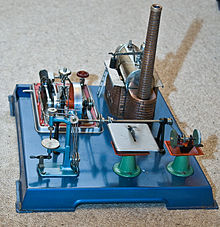- Model steam engine
-
 Stationary model steam engine by Märklin, 1915
Stationary model steam engine by Märklin, 1915
A model steam engine is a small steam engine built as an educational toy for children (in which case it is also called a toy steam engine) or for adult live steam enthusiasts. Between the 18th and early 20th centuries, demonstration models were also in use at universities and engineering schools, frequently designed and built by students as part of their curriculum.[1]
Model steam engines have been made in many forms by a number of manufacturers, but building model steam engines from scratch is popular among adult steam enthusiasts, although this generally requires access to a lathe and/or milling machine.[2] Those without a lathe can alternatively purchase prefabricated cylinders.[3]
Contents
History
In the late 19th century, manufacturers such as German toy company Bing introduced one of the two main types of model/toy steam engines, namely stationary engines with accessories that were supposed to mimic a 19th-century factory.[4] In the early 20th century, mobile engines such as steam locomotives, steam rollers, fire engines, and traction engines appeared. Today, companies such as Wilesco (Germany), Mamod (UK), and Jensen (US) continue to produce model/toy steam engines.
Design features
There is no strict definition for the distinction between toy steam engines and model steam engines, but commonly the former will have fewer features (such as forgoing mechanical lubricators or regulators on the simpler models), operate at lower pressures, and lack a superheater, while the latter will place more emphasis on similarity to life-sized engines. Manufacturers such as Wilesco sell both simple toy engines for beginners (e.g. the D3) and more intricate model engines that are meant to be used to drive e.g. boats.[5]
Model steam engines typically use either hexamine fuel tablets, methylated spirits (aka meths), butane gas, or electricity to heat the boiler. Cylinders are either oscillating (single-acting or double-acting) or slide-valve (normally double-acting).[6] Spring safety valves and steam whistles are other common features of model steam engines. Some stationary engines also have feedwater pumps to replenish boiler water, allowing them to run indefinitely as long as sufficient fuel is available.
Gallery
-
Vintage oscillating-cylinder engine by Cyldon
-
Model steam engine in the Wolfsonian-FIU museum
Notes
- ^ http://www.mne.psu.edu/history/ME/chapter1.html
- ^ Hasluck, p. 10
- ^ Hasluck, p. 21
- ^ Rooks, Marcus (2008). Toy Steam Accessories. p. 4. ISBN 0747803137.
- ^ http://wilesco.de/wilesco/index.php?option=com_content&view=category&layout=blog&id=43&Itemid=55&lang=en
- ^ Hasluck, p. 14
References and further reading
- Stan Bray: Making Simple Model Steam Engines, 192 pp, ISBN 1861267738
- Tubal Cain: Building Simple Model Steam Engines, 112 pp, ISBN 1854861042
- Paul Hasluck: The Model Engineer's Handybook: A Practical Manual on Model Steam Engines. Archive.org e-book
See also
- Live steam
- Model engineering
- Category:Toy steam engine manufacturers
External links
- The Unofficial Mamod and Other Steam Forum (on-line forum about model steam engines)
- Model steam engine photo galleries
- Vintage model steam engine museum
- Online museum of model steam engines from around the world

This toy-related article is a stub. You can help Wikipedia by expanding it. -






